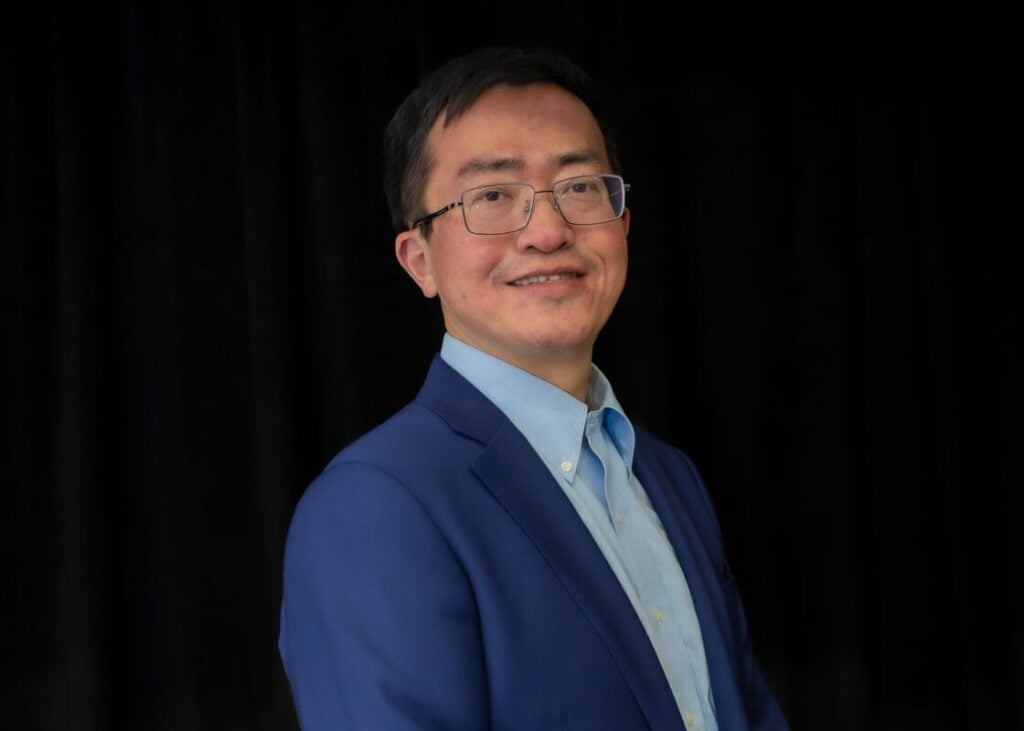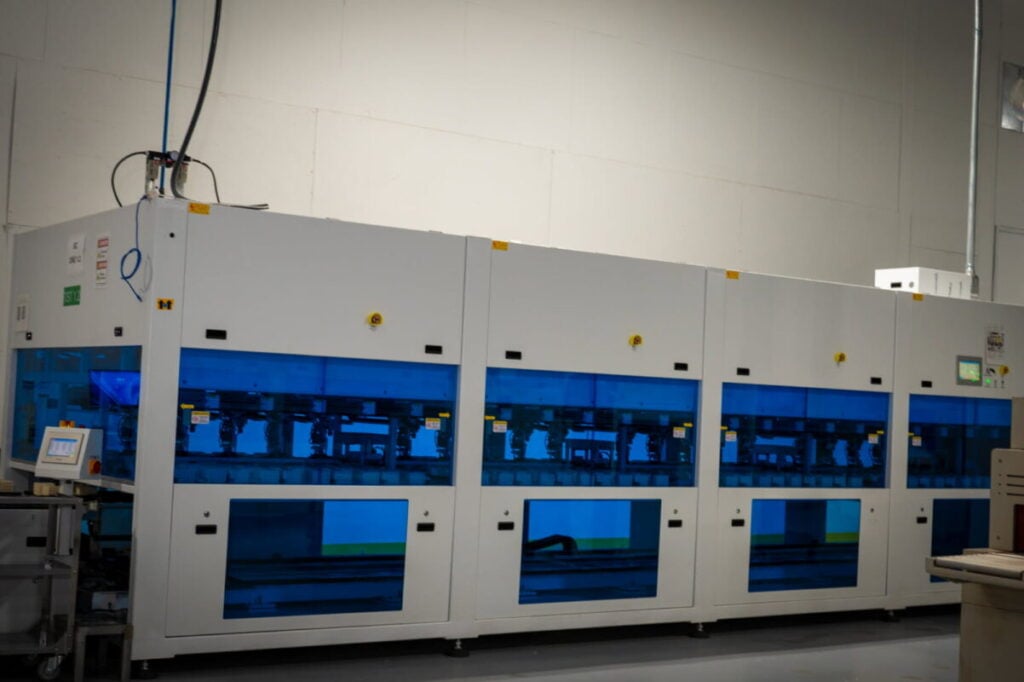
Considering the seismic policy upheavals that have rocked the US solar industry, 2025 is turning out to be a banner year for ES Foundry. In what seems like short order, the new kid on the block of US solar cell production has moved seamlessly from facility completion to commercial production. Supply deals have been signed, and the company is now looking to move into a new expansion phase.
“This year, we held our grand opening at the end of January where we could really start our equipment,” CEO Alex Zhu explains to PV Tech Premium, referencing the completion of its facility in South Carolina. After initial testing in February and March, the company began commercial shipments in April.
Try Premium for just $1
- Full premium access for the first month at only $1
- Converts to an annual rate after 30 days unless cancelled
- Cancel anytime during the trial period
Premium Benefits
- Expert industry analysis and interviews
- Digital access to PV Tech Power journal
- Exclusive event discounts
Or get the full Premium subscription right away
Or continue reading this article for free
“We’re almost five months into shipments. We have three different customers already using our cells to serve their end customers,” Zhu notes, highlighting the company’s swift transition to commercial operations while many competitors remain in early development stages.
“Compared to a lot of other people, most of them are still on the PowerPoint or paperwork stage, talking to investors and trying to raise money for their factories. We are really far away from them. We are shipping,” Zhu says.
Despite recent policy uncertainties, ES Foundry is now moving forward with significant capacity expansion. “We just closed our second phase expansion contract with our main supplier, and we expect the new second phase equipment will come in during Q4. We will finish our expansion from our current 1GW to 3GW by next year,” says Zhu.
This expansion comes after securing multiple long-term supply agreements. “We signed long-term, multiple-year contracts with different customers,” Zhu says, including one with a big US module manufacturer and another deal with a smaller Ohio-based module manufacturer.
The company’s production capacity is fully committed for the foreseeable future. “For our existing line, we’re already sold out until 2027. And for our new expansion, we already have customer commitments for the next two years,” Zhu reveals.
Strategic technology choice: PERC versus TOPCon

As previously reported on PV Tech, ES Foundry has taken the strategic decision to focus on passivated emitter rear contact (PERC) cell technology rather than the market’s current darling, tunnel oxide passivated contact (TOPCon), primarily due to intellectual property concerns.
“Right now, we are still focusing on PERC. For this product technology, we think it’s proven and reliable. The only thing is, efficiency-wise, it’s lower than TOPCon, but with TOPCon, with so many hurdles, I really doubt anybody can produce TOPCon cells in the US without too many legal troubles,” Zhu explains.
When asked about rival company Talon PV securing a TOPCon licence from thin-film specialist First Solar, Zhu remains sceptical: “We will wait and see whether anybody, even Talon with a licence from First Solar, can produce it. You can see whether other people will challenge them.”
He elaborates on the complex patent landscape, which has become a prominent feature of the ultra-competitive module manufacturing market in the past year or so as companies seek any way to gain a competitive advantage over rivals.
“We did all the study before doing the projects, so I understand fully who has the patents and what patents are held by different companies. The only way for TOPCon to work is you have to get the patents from everybody, otherwise you’ll have trouble. But there’s no economical way you can get licences from everybody without being bankrupt.”
Navigating policy uncertainties
Recent policy changes around trade tariffs, the investment tax credit (ITC) and Uyghur Forced Labor Prevention Act (UFLPA) have created significant challenges for US solar manufacturers, and Zhu reveals that these have slowed ES Foundry’s capacity expansion schedule by at least six months.
He elaborates: “With the trade policy, with the ITC, UFLPA, all those uncertainties made it difficult to pull the trigger to start the second phase. Given our original plan, the second phase should have been finished in October this year, but now we’ve pushed to Q1 next year.”
Despite the pressures it has created for developers, for manufacturers such as ES Foundry, recent IRS guidance on safe harbour rules for solar projects seeking tax credits has provided some clarity.
“Only after the IRS issued the guidance recently, all our customers got confirmation. They can continue, they have projects still safe-harboured this year, they have enough project pipeline in the next few years,” Zhu explains. “When we got our customer reconfirmation on their needs for domestic cells, then we said, ‘Okay, with those kind of needs, it’s safer or more realistic to do the expansion.'”
Supply chain considerations
Another current feature of the US solar business is the concern over the supply chain’s ability to meet demand. This is partly a result of increased short-term demand as developers rush to meet the new safe harbour deadlines, and also because of the tightening net of import tariffs and anti-dumping and countervailing restrictions on certain imports.
On the question of supply chain challenges, Zhu notes that ES Foundry relies on imported wafers, primarily from Asia. “I think Southeast Asia will have enough wafer capacity, and people are doing all the necessary checks to comply with UFLPA.
“So, in our view, next year, before the end of year, all those changes should be done, and next year, I think we will have enough wafer supply compliant with UFLPA,” he says.
When asked about potentially sourcing wafers domestically or vertically integrating, Zhu responds: “I think it’s still policy dependent. Right now, we have some wafer supply in the US that actually can work, but the premium they charge on US wafers versus overseas is so high, and none of the end customers—the developers—want to pay for the premium.”
As for ES Foundry producing its own wafers, Zhu is clear: “No, I don’t think we will go to wafers. That’s not our expertise.”
Call for policy stability
Zhu emphasises the need for policy stability for the industry to thrive. “I think it still is based on whether we have a stable policy, and not only about industry policy, but also trade policy,” he says. “For manufacturers, not only like us but also module manufacturers, they are significantly affected by tariffs. We need a very stable, predictable tariff situation.”
He elaborates on the challenges of constantly shifting trade policies: “When we negotiate module supply, when module manufacturers negotiate with developers, they base their assumptions on what the cost will be, what tariff is fixed. Then when the tariff changes in the next two months, six months, nobody knows what’s what.”
Despite these challenges, ES Foundry stands as one of the few operational cell manufacturers in the US market, with secured customers and expansion plans firmly in place, positioning itself as a key player in the emerging domestic solar manufacturing ecosystem.
Alex Zhu will speak at our PV CellTech USA conference in San Francisco on 7-8 October, discussing the evolving PV manufacturing landscape in the US. For full details and booking, click here. PV Tech readers can enjoy a 20% discount on conference registration using the code PVTech20.






